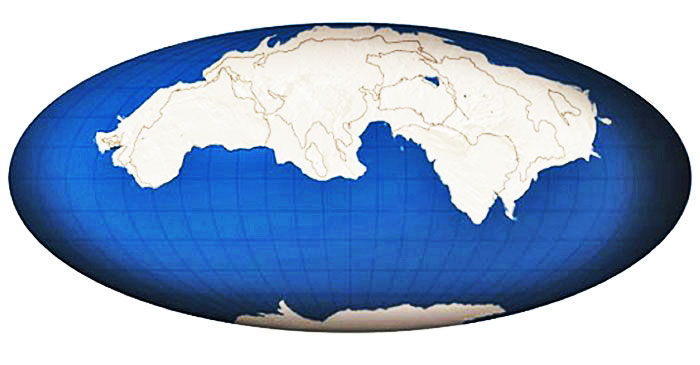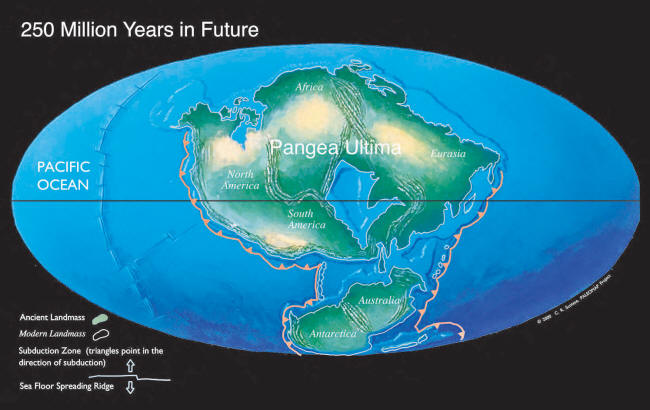|

by A. Sutherland
March
11, 2019
from
MessageToEagle Website

Amasia (also named
Pangea Proxima), is a possible
Pangaea-like supercontinent that will form in the future, more
exactly in 200-250 million years.
However, we are already a halfway in the long process of Amasia's
formation. The peripheries of Australia have slowly begun to collide
with Asia, while the African continent is moving towards Europe.
Amasia future
supercontinent
Scientists predict that the Arctic Ocean and the Caribbean Sea will
disappear, and Asia will crash into the Americas forming a
supercontinent that will stretch across much of the Northern
Hemisphere.
A little different scenario proposes
Christopher R. Scotese, a
geologist and paleogeographer (now retired from teaching at the
University of Texas at Arlington).
He predicts that the
Atlantic, not the Pacific, will close, reconnecting the east
coast of North America to Africa to form "Pangea Proxima" (Amasia).
He believes that it is quite likely that Australia will collide
with Asia in 50 million years, and that Africa will gradually
move towards Europe, making the Atlantic Ocean much larger than
it is today.

from
Atlas of Earth History
So, it means that all
continents will be connected.
In the records of our planet, there have been three supercontinents
in the past 2 billion years.
-
The oldest of
them was supercontinent, Nuna (approximately 1.8 billion
years ago)
-
Rodinia was the
next one and it existed about 1 billion years ago
-
Perhaps the best
known is the most recent, Pangaea, that existed about 300
million years ago and began to break about 180 million years
ago
Supercontinents form and
exist more or less 100 million years and break apart.
Then they form again
setting the pieces adrift to start another cycle.
Scientific
Attempts to Focus on Constant Movement of Continents
There have long been scientific speculations regarding the constant
movement of continents.
A century ago, Alfred Wegener (1880-1930), a German polar
researcher, geophysicist and meteorologist, was the first to try to
prove these movements, scientifically.
Wegener studied important similarities between the petrified remains
of animals and plants found on the continents, which were separated
by oceans. He believed that this may be evidence that these species
existed on these continents, which were previously connected to each
other.
20 years later, Marie Tharp (1920-2006), an American
geologist and oceanographic cartographer who, in partnership with
Bruce Heezen, created the first scientific map of the Atlantic
Ocean floor, in 1950.
Tharp's work revealed the
detailed topography and multi-dimensional geographical landscape of
the ocean bottom.
Her work also revealed
the presence of a continuous rift valley along the axis of the
Mid-Atlantic Ridge, causing a paradigm shift in earth science that
led to acceptance of the theories of plate tectonics and continental
drift.
Simply saying, Tharp made it clear that large mountain chains were
found not only on land, but also underwater. Similar mountains also
lay in the depths of other oceans and helped to realize how the
surface of the Earth is shaped.
Now we know that that continents move continuously and nothing
suggests that this process will stop.
If Scotese's theory is correct, it is probable that one huge
continent on our planet is on the way.
It is worth noting that Scotese's name for Amasia is 'Pangea
Ultima' and this name seems to be wrong. The name could imply that
it would be the last supercontinent in the long history of the
continent formation on Earth.
The process of the
continent movements has continued for a very long and nothing
indicates it stops when Amasia is finally formed.
"…in reality the next
supercontinent will break up in turn and many other
supercontinents will form again before the Earth is destroyed…"
writes Ted Nield in his book 'Supercontinent
- Ten Billion Years in the Life of Our Planet'.
Video
| 


